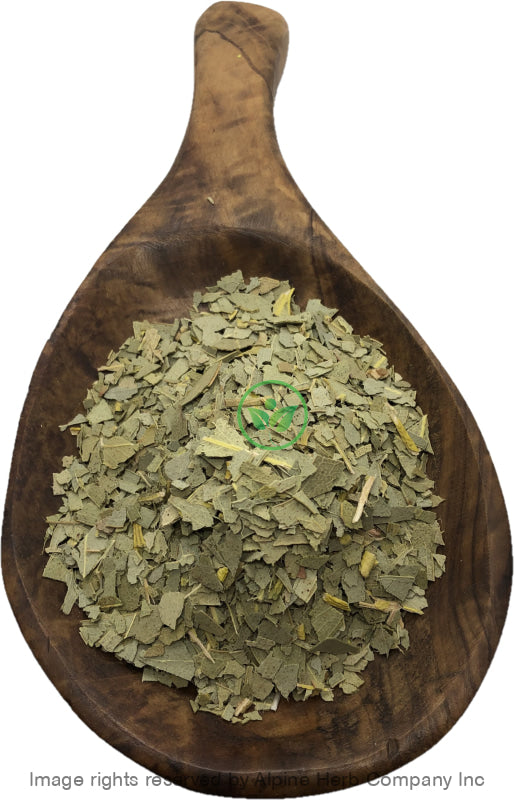Eucalyptus Leaves Cut Alpine Herb Company Inc.
$ 7,49 $ 4,49
Botanical Name: Eucalyptus globulus
Common Name:
- English: Eucalyptus
- Ayurvedic: Tilaparna, Tailaparna
- Unani: Neelgiri
- Also, known as: Blue Gum Tree, Australian Gum tree, Sugandhapatra, Haritaparna Neelaniryaasa, Tribhandi, Triputaa, Saralaa, Suvahaa, Rechani, Nishotraa, Nilgiri, Karpooramaram, Jeevakamu, Yukkaalimaram, Yukkaalimaram, Yukeliptas, Nilaniryasa, Ekalipth, Sugandha Patrah
Habitat: Australia. Now North and South Africa, India, and Southern Europe
Origin: India
Harvested: Cultivated
Parts Used: Leaves
General Information:
Eucalyptus globulus, a large tree attaining a height of 90 m or more, native to Australia, but planted worldwide and introduced in Nilgiris, Annamalai and Palni hills, Simla and Shillong at an altitude of 1500-2500 m. Size of eucalyptus depends on the species. Eucalyptus tree can reach 33 to 200 feet in height. Most eucalyptus species are evergreen plants. Besides in the form of trees, some species of eucalyptus develop as shrubs.
There are over 400 different species of eucalyptus. Eucalyptus globulus, also known as Blue Gum, is the main source of eucalyptus oil used globally.
Leaves of eucalyptus have a lanceolate shape. They are positioned downwards to prevent direct exposure to the sunlight. The bark of the eucalyptus tree is usually brown in color. Rainbow eucalyptus sheds its bark several times per year and reveals inner bark that is multicolored (red, blue, yellow, purple…). Most species of eucalyptus shed their bark once per year. The bark can be removed in long ribbons, spongy pieces, furrowed and rough pieces or small flakes. Eucalyptus is also known as a “gum tree” because of the sticky rubbery substance that flows from the injured bark. All parts of eucalyptus trees are used in the manufacture of dyes. Eucalyptus has white, yellow, pink or red flowers. The Beautiful color of the flowers is the result of the huge number of stamens (male reproductive organs). They do not have petals. Insects, birds and small mammals (such as bats) pollinate eucalyptus flowers. They are attracted by delicious nectar that is produced in big quantity. The fruit of eucalyptus is called gum nut. The lifespan of eucalyptus depends on the species. Most eucalyptus trees can survive more than 250 years in the wild.
Eucalyptus is commercially grown in tropical and subtropical areas all over the world. Since it absorbs huge quantities of water from the ground, eucalyptus can be used for draining of marshes. It can also eradicate malaria by destroying wet habitats which are required for the development of mosquito’s eggs. Unfortunately, the drying of the soil negatively affects other plant species.
The oil that comes from the eucalyptus tree is used as an antiseptic, a perfume, as an ingredient in cosmetics, as a flavoring, in dental preparations, and in industrial solvents.
How to use:
Hot Infusion:
The basic method for dried herbs and flower is, take 2-3 tablespoons of dried herb in a cup or teapot. Pour hot water over it and cover it with lid for 10-30 minutes. Hot water is needed to draw out the antioxidants, enzymes, vitamins, flavonoids, and volatile oils from the botanicals. Strain and squeeze out as much as liquid as possible and enjoy!
Tips:
You can sweeten your herbal tea with a bit of honey, natural fruit juice, stevia leaves powder and or licorice root powder.
You can make ice cubes or pops by freezing tea in ice trays or pop molds.
Precautions:
You should consult with a qualified healthcare practitioner before using any herbal products, particularly if you are pregnant, nursing, or on any medications.
All information on this website is for educational purposes ONLY
This information has not been evaluated by Health Canada.
This information is not intended to diagnose, treat, cure, or prevent any disease.
| Unit Size | 100g, 200g, 400g, 1kg |
|---|
Prompt shipping and expert packing
Thanks to our longstanding association with UPS FedEx DHL as well as other leading global carriers, we can offer a variety shipping options. Our warehouse staff is highly trained and will be able to pack your goods in accordance with our precise and exact specifications. Your items will go through an exhaustive examination before they will be securely packaged before being delivered. We ship to hundreds of thousands of customers daily in different countries. This is a sign of our determination to become the largest online retailer worldwide. Warehouses and distribution centers are located throughout Europe as well as in the USA.
Note that orders containing multiple items are processed according to the particular item.
We will thoroughly inspect all items ordered before shipping. Most orders are shipped within 48 hours. The delivery time will be between 3 and 7 working days.
Returns
The stock market is always changing. It's not entirely managed by us since we're involved with several entities, including the factory and the storage. Therefore, the actual inventory could fluctuate at any moment. Please be aware that it is possible that your order could be out of stock after you've placed your order.
Our policy lasts for 30 days. If it's been more than 30 days since the date you purchased your item We're sorry to say that we can't offer you a full exchange or refund.
You can only return a product if it is unused and still in the same state as when you received it. The item should be in the original packaging.


































